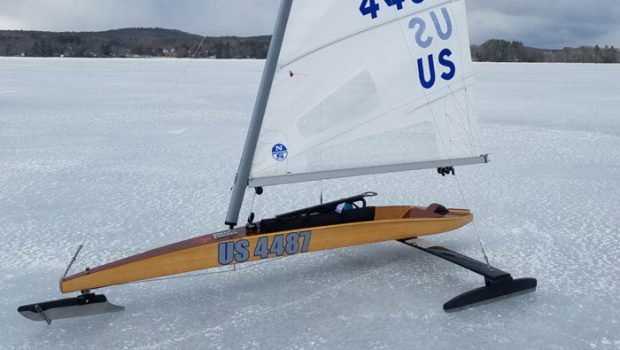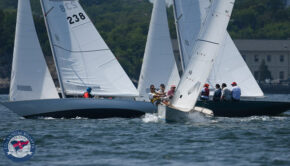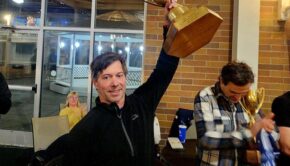DN Iceboating: Innovating for speed
Published on March 9th, 2020
For Chad Atkins and Oliver Moore, winter means fast apparent wind sailing on their DN iceboats—whenever they can find ice and wind within driving distance of Rhode Island.
Chad finished third at the 2020 DN North Americans, his first time ever in the top five—and he was just “one bad leeward mark rounding” shy of winning the whole thing. (Tuning partner James “T” Thieler won the regatta.)
Oliver, who owns the Moore Brothers Company and builds iceboat masts, says its Chad’s tuning that makes him so fast. Chad, who worked with Mike Marshall to develop the North Sails DN inventory, says it’s those composite masts—and the sails designed to match them—that made his speed jump possible.
But both agree that the most significant speed gains are made long before the regatta starts, which is why iceboaters spend so much time developing and dialing in equipment to suit style, body size, and personal preference.
“Most of this stuff is happening before we hit the ice,” Chad says. “Static deflection, bend testing, the development of the mast and the sails and the plank… that’s 75-80% of the speed right there.”
Oliver enjoys that part of the challenge; “It’s the most technical boat I’ve ever sailed, from a setup standpoint.” And he says Chad was the guy who got him into iceboating. “He helped set me up and got me close enough to right that I could be in the conversation. Then you can say, okay, ‘this is the effect I’m trying to achieve.’”
Mast pop
Mast bend characteristics are absolutely critical, and the goal is the same as soft-water sailing: to get powered up as low in the wind range as possible. The ideal look, though, is radically different; the mast is tuned to make it “pop” to leeward. That exerts downward pressure on the iceboat runners, acting (as Oliver puts it) “like a spoiler on a race car,” which makes it possible to push harder without losing control.
“When the breeze builds, the first to get the mast to pop wins,” Oliver says. “So at that point you want a super-soft mast. But as the breeze keeps building, you’re trying to restrain that overbend, because you’re losing power. The way you control that is all in rig geometry: adjusting your shrouds or forestay, and moving your mast.” Once you’re in the ballpark, he says, the entire range is only a couple of turns on the shrouds.
The fuselage (hull) on a DN can vary quite a bit in size and height, but both the length and stiffness of the plank (which runs athwartship and holds the shrouds) are critical. “People are measuring to make sure that when you stand on your plank, it’s bending to the exact millimeter that you think is correct,” Oliver explains.
Sails are built to match each mast and plank’s combined bend characteristics, also factoring in other variables like wind strength, ice conditions, and sailor size. “Some people have four or five different sails—I’ve got two.” Full report.









 We’ll keep your information safe.
We’ll keep your information safe.